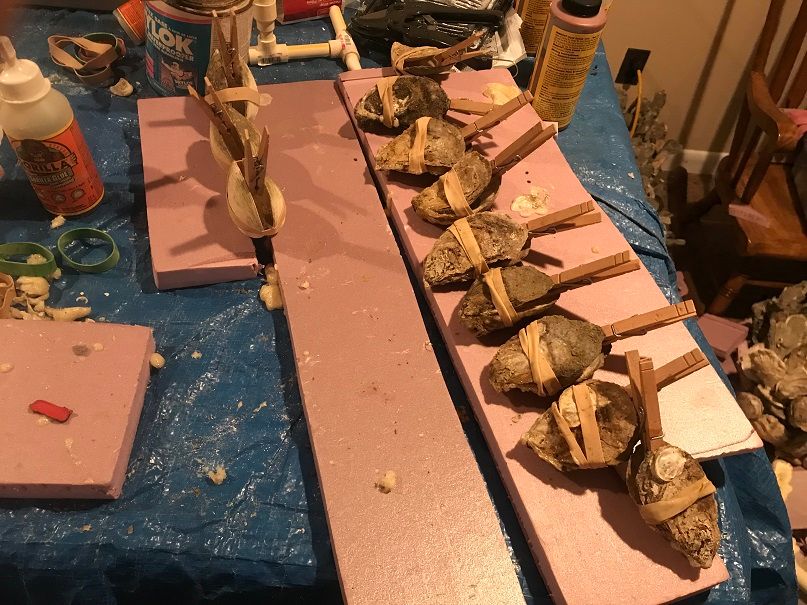Sorry to hear of that. Your fish are quite well known "friends to all." At least, in this neighborhood.

Brackish 20 Long Chesapeake Bay Aquarium
#262

Posted 21 March 2019 - 08:17 AM
Thanks Doug.
I also keep a 20g high oyster reef brackish aquarium, but this is an invertebrate tank only right now. I don't know if I'll keep fish in it or not. I don't do a ton of maintentance on it, just let the inverts do their thing, feed them daily with flakes, and feed the anemones and crabs frozen shrimp now and then. There are at least two species of mud crabs, 3 ghost anemones, about 20 grass shrimp, a few live mussels, a few barnacles, a bunch of amphipods that rarely come out, and a bunch of clam worms (bristle worms). I feed the filter feeders oyster egg solution as well a couple times each week. Once in a while, I get a treat when the crabs, amphipods come out, and also like to watch the anemones eat. Well, last night, I had quite a surprise when I found a grass shrimp feasting on live remains of a half eaten bristle worm that was in the swimming/mating form. I never thought that grass shrimp would do that since they're so timid. I always thought bristle worms would be aggressive too, but, they are not at all aggressive and really help as part of the clean up crew. Anyway, I have a short video of the grass shrimp feast:
Kevin Wilson
#263

Posted 01 April 2019 - 08:50 AM





Kevin Wilson
#264

Posted 01 April 2019 - 02:18 PM
Glad to hear you are still having good luck with the gorilla glue, so long as you used enough of it. I was eating oysters on the half shell over the weekend and thinking of you. Our tanks are so similar it is eerie, with the exception of yours having the oyster reef, which is the sena qua non of a good brackish tank, IMO. I hope to have the time and gumption to build one half is pretty as yours
As your fellow, I can demand of you no more, and accept no less, than I allow to be demanded of myself
#266

Posted 02 April 2019 - 08:25 AM
Thanks Andy. If you build a reef, save the oyster shells and keep them matched as you finish eating them some way. The most time consuming part of building my reef was finding matched shells, painstakingly going through piles of them to match them up. It's much easier if you can find then already matched. Using Gorilla Glue may cost some time, as you need about 2 hours for the glue to set and 24 to cure, but if you're patient, you can build a pretty large reef in a week. It wasn't that difficult, once I got the hang of it.




Kevin Wilson
#270

Posted 03 April 2019 - 07:21 AM

Kevin Wilson
#271

Posted 04 April 2019 - 07:59 AM
I shot a couple videos and uploaded one to YT last night. The fish are still skittish from my hands being in the tank so much. To them, it must have seemed like Godzilla crashing through town when I broke the scape down and set up up again. The fish are cruising the structures and checking out all of the new hidey holes, re-establishing territory, etc. My guess is that egg laying will start again pretty soon. The males are all nicely colored now, which is either a good sign that they're going to spawn soon or that their happy in their new oysterscape. It could be a little of both. Anyway, hope you like the video:
Kevin Wilson
#272

Posted 08 April 2019 - 10:56 AM
Kevin Wilson
#273

Posted 08 April 2019 - 08:03 PM
Awesome tank! Love it!
Know what you mean about being concerned for your fishes' health. I have a male banded darter that's very personable with me and always swims to the top for food when it's feeding time. He's become extremely skinny with a sunken belly and I am worried for his health. I moved him into a smaller tank with a few other darters and my tiny punky so he can get more food. He eats but whether I can bring him back from the condition he's in or not is to be seen. You can only feed them so much without destroying the parameters of the water.
Really NICE job on the oyster reef!
#274

Posted 09 April 2019 - 11:54 AM
Thank you Chris! It sounds like he has internal worm parasites. There are meds you can buy to spike the food with and treat him. Metroplex sticks in my head as one of them that somebody recommended? The website was Reef Central, so I'm not sure if this medication works on freshwater or not.
Kevin Wilson
#275

Posted 15 April 2019 - 09:50 AM
Kevin Wilson
#276

Posted 16 April 2019 - 08:21 AM
Kevin Wilson
#277

Posted 22 April 2019 - 07:19 AM

Kevin Wilson
Reply to this topic
0 user(s) are reading this topic
0 members, 0 guests, 0 anonymous users







